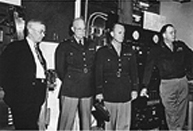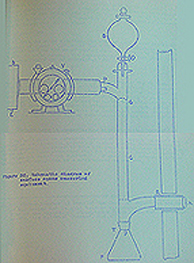Geophysical Institute History "The Beginning" - Part 3

After the end of World War II, the scientific frontier expanded exponentially with
the first programmable computer built to calculate missile trajectories, invention
of the transistor revolutionized electrical circuitry, and introduction of the "big
bang theory" as an explanation for expansion of the universe.
Geophysical research at the University of Alaska also expanded in the new post-war
era. Scientists conducted nouveau exploratory experiments into natural phenomenon
and wrote monthly Research Reports for the Department of Terrestrial Magnetism "DTM."
These reports emphasized the study of chief phenomena of the atmosphere concerning
the aurora, electromagnetic wave propagation, meteors, night skylight, noctilucent
clouds, ozone, solar spectrum, and anomalous sound propagation.
The explosion of research produced new experimental equipment and international recognition.
For example, A.L. Fitzgerald built a device to measure Earth's surface ozone. Stuart
Seaton became the first scientist at University of Alaska to have research results
published in a journal. He published "Experimental Determination of the Gyrofrequency"
on research data obtained from the College Observatory in the very prominent international
journal "Science."

College Hill studies of high-latitude geophysical problems for the War Department and Navy emphasized the need for the United States to establish its own high-latitude research facilities. In 1946, Office of Naval Research established the Naval Arctic Research Laboratory in Barrow, where many Geophysical Institute scientists conducted sea ice research.
The DTM terminated its wartime work in 1946 and turned over the responsibility of
the College Hill facility to the University of Alaska. Since the US Coast and Geodetic
Survey were no longer affiliated with DTM, they wanted to locate their own Magnetic
Observatory on the University of Alaska campus. Congress conducted a survey and approved
this operation as an independent facility. President Bunnell and the Board of Regents agreed to a 99 year lease in the middle of the campus, and the federal facility became
known as the "College Observatory" and in later years the "College Geophysical Observatory."
With increasing scientific interest in the Polar Region, President Bunnell believed
the university required a more permanent facility or institution, instead of a data
collecting facility at the College Observatory. He pulled out the "Harrais Resolution"
of 1936 and reintroduced it to Congress with the help of John Fleming at DTM, Stuart
Seaton the observer-in-charge of the College Observatory, and Bob Bartlett Secretary
of Alaska.
A bill was drafted to authorize an appropriation for the establishment of a Geophysical
Institute at the University of Alaska, Public Law 580.

It passed the House, but a lobbying effort with the executive branch had to be organized
to appeal to the Senate. Secretary of Commerce Henry Wallace was sympathetic and urged
Harry Truman to sign the bill. The President signed the bill into law on July 31,
1946, authorizing an appropriation of $975,000 for the Geophysical Institute. Unfortunately,
the "actual" appropriation had to pass Congress.
President Bunnell fought an uphill battle for two more years. He invited General Dwight
D. Eisenhower to tour the College Observatory on the University campus in 1947. The
Army Chief of Staff expressed his interest in the plan and his regret that he had
not known about it before. Then with testimony from General Eisenhower's staff, eminent
scientists, and representatives from the University, the appropriations bill passed
into law in 1948 by the 80th Congress, Public Law 491.
Public Law 491 provisioned the founding of the Geophysical Institute with the University
of Alaska slated to operate and staff the institute with a director approved by the
National Academy of Sciences, a librarian, and a secretary.

The bill had been changed from being owned by the University of Alaska to the United
States. The University of Alaska still received its institute, but the school had
to give up a piece of its campus to the federal government. It was a heavily fought
provision in the following years and eventually the federal government turned over
the Geophysical Institute to the State of Alaska.
Stuart Seaton "Visionary" became the first director of the Geophysical Institute and
organized the construction of the Geophysical Institute's research building (now the
Chapman Building). The building, modern for its time, had a wide array of scientific equipment such
as seismic recorders anchored in bedrock and independent of the building, a penthouse
laboratory, and a retractable astronomical dome on the roof that contained telescopes,
auroral cameras, and other meteorological instruments. The cornerstone was laid in
the spring of 1949 with fanfare and full Masonic ceremonies (see photo). A copper
box was entombed in the cornerstone containing newspaper articles, a university catalog,
a commencement program, photographs of construction plans, copies of legislative Public
Laws 491 & 580, a harpoon head from St. Lawrence Island, a fragment of Alaska jade,
a gold nugget, coin of the realm (1, 5, 10 cents 1 dollar) and a vacuum tube indicative
of scientific achievement.
Seaton's tenure as the institute's director coincided with the completed construction
of the Geophysical Institute in 1950. That year, a conflict arose between Seaton and
newly appointed University President Moore. Bunnell and Seaton envisioned the Geophysical Institute as an administratively and
financially independent arm of the university, which would serve as the core of the
university's future graduate school. Moore wanted the graduate program to be directed
by faculty who had earned doctorate degrees, which did not include Seaton, and he
wanted the Geophysical Institute to pay for utilities out of overhead received from
grants and contracts.
In the spring of 1950, Seaton and about two-thirds of the Geophysical Institute staff
went to the Board of Regents and threatened to resign en masse claiming that the newly appointed President Moore
was trying to take over the institute. Moore during the meeting restated his position
and revealed the US Bureau of Standards had problems regarding the quality and quantity
of research being conducted at the Geophysical Institute. The Board of Regents upheld
Moore's position and fired Seaton and staff.
For some time the Geophysical Institute's halls remained nearly deserted while newly
appointed director William Wilson, a chemistry professor, assembled a first-rate research
staff led by advisory scientific director Sydney Chapman and institute managing director Christian Elvey. A new chapter in the Institute's history began called the Chapman-Elvey Era.
Sources:
Cole, Terrence. The Cornerstone on College Hill An Illustrated History of the University of Alaska Fairbanks. 1994. University of Alaska Press. Bookcrafters, Inc.
Davis, Neil. The College Hill Chronicles How the University of Alaska Came of Age. 1992. University of Alaska Foundation. Bookcrafters, Inc.
Fitzgerald, A.L. A Study on the Chemical Methods of the Measurement of Surface Ozone. State of the Earth's Atmosphere in the Arctic. Reports of the Geophysical Institute University of Alaska. Research Report No. 5 Aug. 16, 1949. University of Alaska Geophysical Institute.
Seaton, Stuart L. Experimental Determination of the Gyrofrequency. Science. Vol. 106, No.2760, Nov 21, 1947.
Links:
Geophysical Institute History website here
Keith B. Mather Library for the Geophysical Institute & International Arctic Research website here
